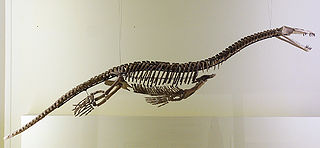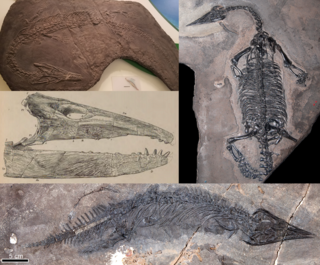
Nothosaurus is an extinct genus of sauropterygian reptile from the Triassic period, approximately 240–210 million years ago, with fossils being distributed from North Africa and Europe to China. It is the best known member of the nothosaur order.

Placodonts are an extinct order of marine reptiles that lived during the Triassic period, becoming extinct at the end of the period. They were part of Sauropterygia, the group that includes plesiosaurs. Placodonts were generally between 1 to 2 m in length, with some of the largest measuring 3 m (9.8 ft) long.

Pachypleurosauria is an extinct clade of primitive sauropterygian reptiles that vaguely resembled aquatic lizards, and were limited to the Triassic period. They were elongate animals, ranging in size from 0.2–1 metre (0.66–3.28 ft), with small heads, long necks, paddle-like limbs, and long, deep tails. The limb girdles are greatly reduced, so it is unlikely these animals could move about on land. The widely spaced peg-like teeth project at the front of the jaws, indicating that these animals fed on fish. In the species Prosantosaurus, it was observed that they fed on small fishes and crustaceans which they devoured entirely and that its teeth regrew after they broke off. This was the first observation of tooth replacement in a European pachypleurosaur, the only other discovery of such an event was made in China.

Ceresiosaurus is an extinct aquatic genus of lariosaurine nothosaurid sauropterygian known from the Middle Triassic of Monte San Giorgio, southern Switzerland and northern Italy. Ceresiosaurus, meaning "Lizard of Ceresio". The type species, Ceresiosaurus calcagnii, was named by Bernhard Peyer in 1931. C. calcagnii is known from both the Cava superiore and Cava inferiore beds of the Lower Meride Limestone at Monte San Giorgio, dating to the latest Anisian of the Middle Triassic. Rieppel (1998) suggested that the back then monospecific genus Ceresiosaurus, is a junior synonym of the better known Lariosaurus, yet he kept it type species as a separate species under the new combination L. calcagnii. In 2004, however, this synonymy was objected by Hänni who described and name a second species of Ceresiosaurus, C. lanzi - a separation supported by several other authors since. This species is known only from the stratigraphically younger Cassima beds of Monte San Giorgio, although also from the Lower Meride Limestone, dating to possibly the lowest Ladinian age. The species in a subtropical lagoonal environment with varying open marine influences, and alongside many related but smaller species of nothosaurids and pachypleurosaurids. Ceresiosaurus represents one of the largest vertebrate of up to 3 m (9.8 ft) snout-tail length from the very diversified paleoenvironment of the Middle Triassic Monte San Giorgio.

Cyamodus is a genus of placodonts known from several species described from Middle-Late Triassic of Europe and China. The genus was described by Christian Erich Hermann von Meyer in 1863, based on specimens found in Germany. Like some other placodonts, Cyamodus has an armoured carapace composed of irregular hexagonal plates, with the mouth containing a small number of large, rounded teeth that were likely involved in crushing hard shelled organisms (durophagy).

Paraplacodus broilli is an extinct placodont sauropterygian from the middle Triassic period, from the Anisian until Ladinian stages. The fossils were uncovered in Northern Italy and the species was named in 1931 by Bernhard Peyer. Paraplacodus means "Almost Placodus", in reference to its similarity to Placodus.

Thalattosauria is an extinct order of prehistoric marine reptiles that lived in the middle to late Triassic period. Thalattosaurs were diverse in size and shape, and are divided into two superfamilies: Askeptosauroidea and Thalattosauroidea. Askeptosauroids were endemic to the Tethys Ocean, their fossils have been found in Europe and China, and they were likely semiaquatic fish eaters with straight snouts and decent terrestrial abilities. Thalattosauroids were more specialized for aquatic life and most had unusual downturned snouts and crushing dentition. Thalattosauroids lived along the coasts of both Panthalassa and the Tethys Ocean, and were most diverse in China and western North America. The largest species of thalattosaurs grew to over 4 meters (13 feet) in length, including a long, flattened tail utilized in underwater propulsion. Although thalattosaurs bore a superficial resemblance to lizards, their exact relationships are unresolved. They are widely accepted as diapsids, but experts have variously placed them on the reptile family tree among Lepidosauromorpha, Archosauromorpha, ichthyosaurs, and/or other marine reptiles.

Macrocnemus is an extinct genus of archosauromorph reptile known from the Middle Triassic of Europe and China. Macrocnemus is a member of the Tanystropheidae family and includes three species. Macrocnemus bassanii, the first species to be named and described, is known from the Besano Formation and adjacent paleontological sites in the Italian and Swiss Alps. Macrocnemus fuyuanensis, on the other hand, is known from the Falang Formation in southern China. A third species, Macrocnemus obristi, is known from the Prosanto Formation of Switzerland and is characterized by gracile limbs. The name Macrocnemus is Greek for "long tibia".

Helveticosaurus is an extinct genus of diapsid marine reptile known from the Middle Triassic of southern Switzerland. It contains a single species, Helveticosaurus zollingeri, known from the nearly complete holotype T 4352 collected at Cava Tre Fontane of Monte San Giorgio, an area well known for its rich record of marine life during the Middle Triassic.

Sinosaurosphargis is an extinct genus of basal marine saurosphargid reptile known from the Middle Triassic Guanling Formation of Yunnan and Guizhou Provinces, southwestern China. It contains a single species, Sinosaurosphargis yunguiensis.

Wumengosaurus is an extinct aquatic reptile from the Middle Triassic Guanling Formation of Guizhou, southwestern China. It was originally described as a basal eosauropterygian and usually is recovered as such by phylogenetic analyses, although one phylogeny has placed it as the sister taxon to Ichthyosauromorpha while refraining from a formal re-positioning. It was a relatively small reptile, measuring 95.5–130.5 cm (3.13–4.28 ft) in total body length and weighing 6 kg (13 lb).
Largocephalosaurus is an extinct genus of basal saurosphargid, a marine reptile known from the Middle Triassic Guanling Formation of Yunnan and Guizhou Provinces, southwestern China. It contains a type species, Largocephalosaurus polycarpon, and a second species L. qianensis.

The Erfurt Formation, also known as the Lower Keuper, is a stratigraphic formation of the Keuper group and the Germanic Trias supergroup. It was deposited during the Ladinian stage of the Triassic period. It lies above the Upper Muschelkalk and below the Middle Keuper.

Silvestrosaurus is an extinct aquatic genus of lariosaurine nothosaurid sauropterygian known from the Middle Triassic of Monte San Giorgio, southern Switzerland. It contains a single species, Silvestrosaurus buzzii, originally considered to be a species of the closely related Lariosaurus. The species was named by Tschanz in 1989, based solely on the holotype PIMUZ T/2804 comprising the skull, the lower jaw, and a dis-articulated partial postcranial skeleton. Cyamodus hildegardis tooth bearing elements were found in the stomach region of the specimen. The holotype was collected at Punkt 902 of Monte San Giorgio, from layer 97 of the Grenzbitumen zone, dating to the Anisian-Ladinian boundary of the Middle Triassic. Kuhn-Schnyner (1990) reassigned the species to its own genus, creating the combination S. buzzii. The generic name honors a church near the collection locality of the holotype, dedicated to Saint Sylvester, a Pope during the reign of Constantine the Great, and from Greek saurus, meaning "lizard", a common suffix for genus names of extinct reptile.

Saurosphargidae is an extinct family of marine reptiles known from the early Middle Triassic of Europe and China.
Saurosphargis is an extinct genus of a basal marine reptile, saurosphargid, known from the Middle Triassic of southwestern Poland and eastern Netherlands. It contains a single species, Saurosphargis volzi.

Eusaurosphargis is an extinct genus of a diapsid reptile, known from the Middle Triassic Besano Formation of northern Italy and Prosanto Formation of south-eastern Switzerland. It contains a single species, Eusaurosphargis dalsassoi. It was a small reptile, measuring 20 cm (7.9 in) long.

Pectodens is an extinct genus of archosauromorph reptile which lived during the Middle Triassic in China. The type and only species of the genus is P. zhenyuensis, named by Chun Li and colleagues in 2017. It was a member of the Archosauromorpha, specifically part of the unnatural grouping Protorosauria. However, an unusual combination of traits similar and dissimilar to other protorosaurs initially led to confusion over its evolutionary relationships. In 2021, it was placed in a newly-established group, Dinocephalosauridae, along with its closest relative Dinocephalosaurus.
The Besano Formation is a geological formation in the southern Alps of northwestern Italy and southern Switzerland. This formation, a short but fossiliferous succession of dolomite and black shale, is famous for its preservation of Middle Triassic marine life including fish and aquatic reptiles. It is exposed in the vicinity of Monte San Giorgio and is among the formations responsible for the area being designated as a UNESCO World Heritage Site. In Switzerland, it is also known as the Grenzbitumenzone.































